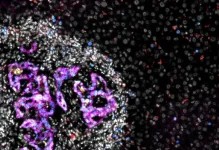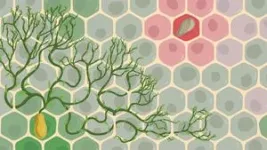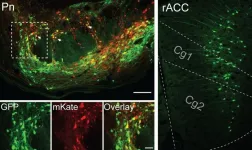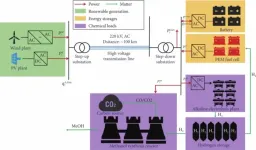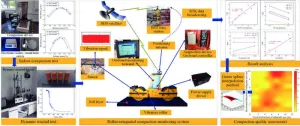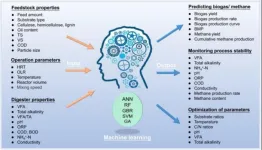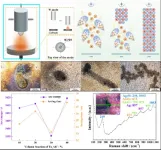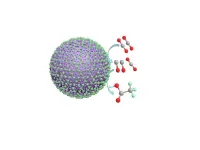(Press-News.org) In brief:
ETH Zurich researchers have discovered proteins on the surface of colorectal cancer cells and liver cells that bind together and that play a major role in the formation of new metastases.
The binding of the proteins triggers fundamental changes in colorectal cancer cells that allow them to take root in the liver.
These new findings will help to develop future treatments that may hinder the formation of often fatal metastases.
In cases where cancer is fatal, nine out of ten times the culprit is metastasis. This is when the primary tumour has sent out cells, like seeds, and invaded other organs of the body. While medicine has made great progress in treating primary tumours, it is still largely helpless in the face of metastasis. Currently, there are no medications that prevent this process.
A team of researchers led by Andreas Moor in the Department of Biosystems Science and Engineering at ETH Zurich in Basel have now published results in the journal, Nature, showing how colorectal cancer cells colonise the liver. Their findings will help to develop treatments with which it may be possible to hinder the metastatic process.
Molecular docking mechanism unlocked
Cancer is said to metastasise when cells from the primary tumour break off and travel via the circulatory system to other parts of the body. “Colorectal cancer metastasises to the liver because of how our blood flows,” Moor says. Blood is first enriched with nutrients in the intestines before it goes to the liver, which metabolises the nutrients. For colorectal cancer cells, the liver is the last stop. “They get caught in the liver’s capillary network,” Moor says.
Costanza Borrelli, a doctoral student, and other members of Moor’s team have now shown that the liver cells also play a large role in whether or not the cancer cells lodged there can colonise their new location. Science has known for over a century that, much like plant seeds in soil, cancer cells are dependent on their environment, yet it was previously unknown which molecular mechanisms play a role here.
Using sophisticated tests on genetically modified mice, Moor and his team have discovered that the secret lies in certain proteins on the cell surface. When liver cells have a protein called Plexin-B2 and the colorectal cancer cells possess certain proteins from the semaphorin family, the colorectal cancer cells can attach themselves to the liver cells.
Signposts in the nervous system
Cancer cells that have semaphorins on their surface are especially dangerous, as attested by clinical studies cited by Moor’s researchers in their paper. The study data shows that colorectal cancer metastasises earlier and more frequently to the liver if the tumour has large amounts of semaphorin.
Plexin and its counterpart semaphorin were previously known to the research community for their function in the nervous system, where the two proteins steer growing nerve cells and ensure they form the right pathways. “Why liver cells also create plexin and what this protein does in healthy livers is anything but clear – and interests us immensely,” Moor says. In other words, the question of its function remains open.
Return to sedentary state
What Moor and his team have discovered, however, is that direct contact between plexin and semaphorin triggers fundamental changes in colorectal cancer cells. To break off from the primary tumour, the cancer cells have to change their identity: they free themselves from the surface layer of the intestine, or epithelium, severing their close connections to neighbouring cells.
Once in the bloodstream, the cancer cells resemble those from connective tissue called mesenchyme. Yet once they find their new niche – thanks to the plexin on some liver cells – the cancer cells turn back into their sedentary form. “An epithelisation process takes place,” the researchers wrote in their paper. Moor expands: “You can spot this immediately if you look at the cancer cells, as they form invaginations similar to the folds or crypts in the intestines.”
The researchers’ discovery will have an impact on more than colorectal cancer patients: further tests have shown that plexin also encourages the formation of metastases in melanoma and pancreatic cancer. For Moor and his team, this throws up many new research questions. One in particular is drawing their focus: when cancer cells cluster together to form a tumour, they also influence cells in their environment. “Cancer cells set up their own ecosystem,” Moor explains.
Critical period of time
If efforts to inhibit the crucial interaction between plexin and semaphorin succeed, it may be possible to prevent the cancer from establishing new tumours in the first place. That’s because early on, when the relationships among the cells in this ecosystem have not yet been firmly established, tumour metastases are especially vulnerable, Moor explains. He appears confident that an answer lies within this “critical period of time in the development of metastases”, even though the path to any potential treatment is still long.
Reference
Borrelli C, Roberts M, Eletto D, Hussherr MD, Fazilaty H, Valenta T, Lafzi A, Kretz JA, Guido Vinzoni E, Karakatsani A, Adivarahan S, Mannhart A, Kimura S, Meijs A, Baccouche Mhamedi F, Acar IE, Handler K, Ficht X, Platt RJ, Piscuoglio S Moor AE: In vivo interaction screening reveals liver-derived constraints to metastasis. Nature, 24 July 2024, doi: 10.1038/s41586-024-07715-3
END
Preventing cancer cells from colonizing the liver
2024-07-24
ELSE PRESS RELEASES FROM THIS DATE:
Neuroscientists discover brain circuitry of placebo effect for pain relief
2024-07-24
CHAPEL HILL, NC – The placebo effect is very real. This we’ve known for decades, as seen in real-life observations and the best double-blinded randomized clinical trials researchers have devised for many diseases and conditions, especially pain. And yet, how and why the placebo effect occurs has remained a mystery. Now, neuroscientists have discovered a key piece of the placebo effect puzzle.
Publishing in Nature, researchers at the University of North Carolina School of Medicine– with colleagues from Stanford, the Howard Hughes Medical Institute, and ...
'Gene misbehavior' widespread in healthy people
2024-07-24
Scientists have uncovered that ‘gene misbehaviour’ – where genes are active when they were expected to be switched off – is a surprisingly common phenomenon in the healthy human population.
The team also identify several mechanisms behind these gene activity errors. This may help inform precision medicine approaches and enable the development of targeted therapies to correct expression.
Researchers from the Wellcome Sanger Institute, the University of Cambridge and AstraZeneca studied the activity of inactive genes in a large, healthy population for the first time. While rare at the individual gene level, they revealed misexpression ...
Arc Institute welcomes first Scientific Advisory Board members; appoints two new members to Board of Directors
2024-07-24
Today, Arc Institute, the scientific research organization pioneering new models for scientific discovery and translation, is announcing the creation of its Scientific Advisory Board and its first two Scientific Advisors, as well as the appointment of two new members to the Arc Board of Directors.
New Scientific Advisory Board
Dr. Carolyn Bertozzi, Ph.D., and Dr. Aviv Regev, Ph.D., join as the first two members of Arc’s Scientific Advisory Board and will provide strategic guidance, share their ...
NCCN Oncology Research Program celebrates 25 years of advancing cancer science
2024-07-24
PLYMOUTH MEETING, PA [July 24, 2024] — The National Comprehensive Cancer Network® (NCCN®)—an alliance of leading cancer centers—commemorates the 25th anniversary of the NCCN Oncology Research Program (ORP). The NCCN ORP is dedicated to seeking innovative, effective, and equitable cancer care through oversight and funding for cancer research and quality improvement projects. Over the past quarter-century, the NCCN ORP has managed a diverse portfolio of more than 180 research studies and quality improvement projects to improve quality and outcomes for people with cancer. The NCCN ORP has also provided project oversight to 75 NCCN Foundation® Young Investigator Award ...
From grey to green: unveiling the future of renewable e-methanol for cleaner shipping fuels
2024-07-24
Methanol is a crucial chemical feedstock and a potential green fuel, particularly for the shipping industry. Currently, its production predominantly relies on fossil feedstocks, leading to high greenhouse gas emissions. With the global push towards decarbonization, there is an urgent need to explore cleaner alternatives like renewable e-methanol. Based on these challenges, there is a need for in-depth research to develop sustainable methanol production methods.
A team of researchers from Tsinghua ...
A brittle interface with low modulus to improve the mechanical properties of multiphase ceramics: A unique design approach?
2024-07-24
Barium strontium aluminum silicate (BaxSr1−xAl2Si2O8, BSAS) ceramics possess both phase stability and resistance to water vapor corrosion, making them ideal materials for radome technology and electronic packaging. To address the low tolerance of BSAS ceramics to damage and defects, the introduction of nano-reinforcements is an effective approach to enhance their strength and toughness. SiC nanowires (SiCnws) exhibit high strength and hardness inherited from SiC ceramics, along with the excellent toughness and elasticity ...
Intelligent compaction: ensuring highway durability with advanced monitoring
2024-07-24
Highway construction often faces challenges in ensuring long-term subgrade performance due to traditional compaction quality control (QC) methods that rely on manual adjustments and sporadic testing. These methods are susceptible to human error, inefficiency, and incomplete assessments. Addressing these issues requires advanced, real-time monitoring systems. Such systems can provide comprehensive and accurate QC, highlighting the need for innovative technologies to improve highway construction standards.
Researchers from the University of Science and Technology Beijing, alongside partners from Hunan and China Renewable Energy Engineering ...
From trash to treasure: machine learning enhances organic waste recycling
2024-07-24
Biological treatment methods such as anaerobic digestion, composting, and insect farming are essential for managing organic waste, converting it into valuable resources like biogas and organic fertilizers. However, these processes often face challenges due to their inherent complexity and instability, which can affect efficiency and product quality. Traditional control strategies have limited success in addressing these issues. Therefore, advanced methods like machine learning (ML) are being explored to enhance prediction, optimization, and monitoring of these biological treatments, aiming to improve overall performance and sustainability.
A research team from Tongji University ...
g-Ta2AlC, A new electrical contact material
2024-07-24
Relays are extensively utilized in accelerators, satellites, rockets, and various advanced technology sectors. They play crucial roles in signal transmission, long-distance control implementation, and protection circuits, directly impacting the safety of aerospace and defense equipment systems. The selection of electrical contact material in a relay is crucial for its performance. Arc discharge, characterized by high temperature, heat, and energy, is a common occurrence during operation. Consequently, the arc erodes the electric contact material, ...
Reducing carbon dioxide to acetate with a polyaniline catalyst coated in cobalt oxide nanoparticles
2024-07-24
Acetic acid, also known as acetate, and other products that can be developed from acetic acid are used in a variety of industries, from food production to medicine to agriculture. Currently, acetate production uses a significant amount of energy and results in harmful waste products. The efficient and sustainable production of acetate is an important target for researchers interested in improving industrial sustainability.
A paper published in Carbon Future on July 9 outlines a method using a polyaniline catalyst with cobalt oxide nanoparticles to produce acetate through carbon dioxide electroreduction.
“The polyaniline catalyst with cobalt ...
